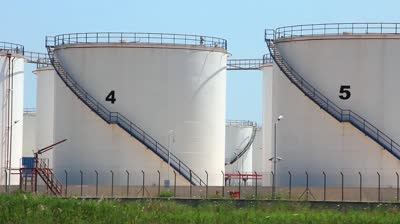Introduction
The design of storage tanks for crude oil and petroleum products requires, in general, careful consideration of the following important factors:
_ The vapor pressure of the materials to be stored.
_ The storage tank temperature and pressure.
_ Toxicity of the petroleum material
In order to meet the environmental constraints on air pollution, to prevent fire hazards, and to avoid losses of valuable petroleum products at the same time, it is recommended to adopt the following:
_ The use of floating-roof tanks for petroleum materials with a vapor pressure of 1.12–11.5 psia (at the storage temperature) or Using fixed-roof tanks along with the VRU system.
Storage tanks for crude oil are needed in order to receive and collect oil produced by wells, before pumping to the pipelines as well as to allow for measuring oil properties, sampling, and gauging.
Types of Storage Tank
The atmospheric tank, or standard storage tank, is one that is designed to be used within plus or minus a few pounds per square inch of atmospheric pressure. It may be open to the atmosphere (vented) or enclosed.
An effective method of preventing vent loss in a storage tank is to use one of the many types of variable-volume tank.
These are built under API Standard 650. They may have floating roofs of the double-deck or single-deck type. These are lifter roof types in which the roof either has a skirt moving up and down in an annular seal or is connected to the tank shell by a flexible membrane.
read also Storage Tanks Types
Sizing the Storage Tanks
The following is the guidelines to estimate the storage tank capacity for an oil producing facility; select the number of storage tanks of crude oil.
- To determine the capacity of storage tanks, the following rules apply:
(a) For one well, the capacity per storage tank should be adequate enough for at least 2–3 days’ production.
(b) For a group of wells (entire field), the total tank capacity should be adequate enough for at least 3–4 days of oil production by that field.
- To determine the number of storage tanks as a function of the number of producing wells.
To illustrate the application of these guidelines, the following example is cited. However, it should be emphasized that their use is restricted to small- to medium-size oil field installations.
Vapor Recovery Units VRU
The loss of hydrocarbon vapors formed above crude oil or its products— when stored—could be minimized using what is called vapor recovery units (VRUs). If allowed to escape to the atmosphere, these vapors will not only cause a loss of income due to loss of hydrocarbon volume and change in the API of the oil but will also lead to pollution and fire hazards.
The three main functions for the vapor recovery system as follows:
- To collect vapor from storage/loading facilities
- To reliquefy vapors
- To return liquid hydrocarbons to storage
Basically, when we talk about a VRU, what we are looking for is to hook our storage tanks to a ‘‘breather’’ system such as the following:
_ During the day, when the temperature rises and vaporization of the hydrocarbons occur, excess vapors can be released and collected by the VRU.
_ At night, when the vapors cool and condensation takes place leading to partial vacuum, vapors from the VRU will be admitted into the storage tanks.
_ While pumping in and pumping out liquids to and from the storage tanks, vapors could be vented, [i.e., collected and drawn in, respectively, by such a breather system (VRU)].
see our Storage Tanks Books
Types of Storage Loss
In general, hydrocarbon losses in storage tanks are identified as follows:
Working losses
(a) Filling
(b) Emptying
Other losses
(a) Breathing
(b) Standing
(c) Boiling
Filling losses occur when vapors are expelled from a tank as it is filled, no matter how the vapors are produced. This loss occurs when the pressure inside the tank exceeds the relief-valve pressure. For API tanks, the relief pressure is low and, therefore, filling losses can be relatively high.
Emptying losses are experienced by the vapors that are expelled from a tank after the liquid is removed from it. Because vaporization lags behind the expansion of the vapor space during withdrawal, the partial pressure of a hydrocarbon vapor drops. Enough air enters during the withdrawal to maintain the total pressure at the barometric value.
However, when vaporization into the new air reaches equilibrium, the increase in the vapor volume will cause some vapor expansion. Breathing losses occur when vapors are expelled from a tank under one of the following conditions:
- The thermal expansion of the existing vapors
- An expansion caused by barometric pressure changes
- An increase in the amount of vapors from added vaporization in the absence of a liquid level change Breathing losses take place in most types of tanks and occurs when the tank’s limits of pressure or volume changes are exceeded.
The fixed-roof API type tanks used to store stock tank oil are designed for only for a few inches of water pressure or vacuum and suffer relatively large breathing losses.
Standing losses are losses of vapor which result from causes other than breathing or a change in liquid level in tanks. Sources of standing losses are vapor escape from hatches or other openings and from glands, valves, and fittings.
Boiling losses occur when liquid boils in a tank and vapors are expelled. In other words, the vapor pressure of the liquid exceeds the surrounding pressure.
References :
- Petroleum and Gas Field Processing.
- Oil and Gas Production Handbook.

